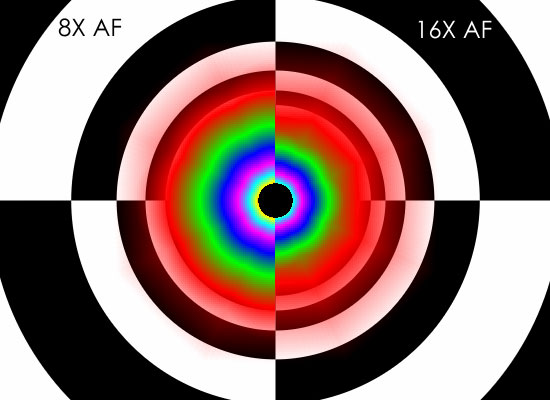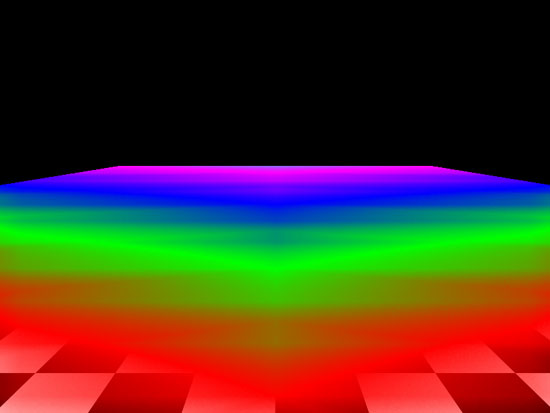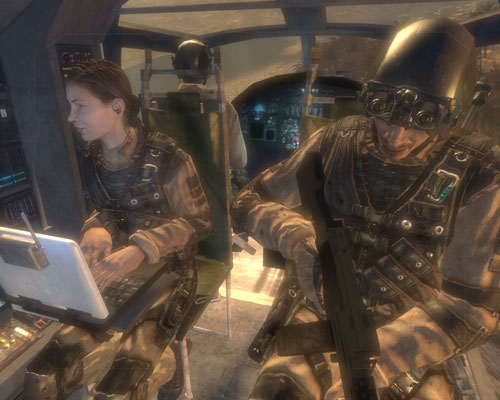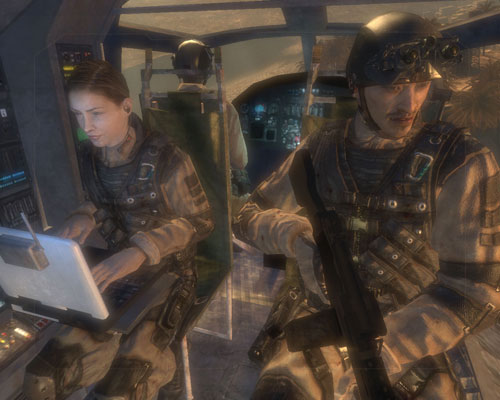ATI Radeon HD 2900 XT: Calling a Spade a Spade
by Derek Wilson on May 14, 2007 12:04 PM EST- Posted in
- GPUs
General Image Quality
Beyond antialiasing, there are quite a number of factors that go into making real-time 3D look good. Real-time graphics are an optimization problem, and the balance between performance and quality is very important. There is no single "right" way to do graphics, and AMD and NVIDIA must listen carefully to developers and consumers to deliver what they believe is the sweet spot between doing things fast and doing things accurately.
NVIDIA currently offers much more customizable image quality. Users are able to turn on and off different optimizations as they see fit. AMD really only offers a couple specific settings that affect image quality, while most of their optimizations are handled on a per game basis by the ominous feature known as Catalyst A.I. The options we have are disabled, standard and advanced. This doesn't really tell us what is going on behind the scenes, but we leave this setting on standard for all of our tests, as this is the default setting and most users will leave it alone.
Aside from optimizations, texture filtering plays a large role in image quality when high levels of filtering are called for. It's trivial to point sample or bilinear filter, and no one skimps on these duties, but when we get to trilinear and anisotropic filtering the number of texture samples we need and the number of calculations we must perform per pixel go up very quickly. In order to mitigate the cost of these operations, both AMD and NVIDIA attempt to apply high levels of filtering where they are needed and not-so-high levels of filtering where it won't matter that much. Of course there is much debate over where to draw the lines here, and NVIDIA and AMD both choose different paths.
To investigate texture filtering quality, we have employed the trusty D3D AF-Tester. This long-lived application enables us to look at one texture with different colored mipmap levels to see how hardware handles filtering them under different settings. Thankfully, we don't have to talk about angle dependent anisotropic filtering (which is actually a contradiction in terms anyway). AMD and NVIDIA both finally do good quality anisotropic filtering that results in higher resolutions textures being used more of the time where possible. Take a look at these images to see how the different hardware stacks up.

NVIDIA G80 Tunnel 8x/16x AF
G80
R5xx
R6xx
It still looks like NVIDIA is doing slightly more angle independence filtering. In practice, it will be very difficult to tell the difference between an image rendered on AMD hardware and one rendered on NVIDIA hardware. We can also see that AMD has slightly tweaked their AF technique to eliminate some of the odd transitions we noticed on R5xx hardware. This comes through a little better if we look at a flat plane:

AMD R600 Plane 8x AF
R5xx
R6xx
We did happen to notice at least one image quality issue not related to texture filtering on AMD hardware. The problem turns up in Rainbow Six: Vegas in the form of very bad banding where we should see HDR lighting. We didn't notice this problem on G80, as we can see from our comparison.
  |
| Click to enlarge |
We also noticed a small issue with Oblivion at one point where the oblivion gate shader would bleed through other objects, but this was not reproducible and we couldn't get a screenshot of it. This means it could be a game related issue rather than a hardware or driver problem. We'll keep our eyes peeled.
Overall IQ of the current DX10 hardware available is quite good, but we will continue to dig further into the matter to make sure that everything stays that way. We're also waiting for DX10 games before we can determine if there are other differences, but hopefully that won't be the case as DX10 has a single set of requirements.










86 Comments
View All Comments
TA152H - Monday, May 14, 2007 - link
Fanboy? What a dork.I've had success with ATI, not with NVIDIA, and I know ATI stuff a lot better so it's just easier for me to work with. It's not an irrational like or dislike. I bought one NVIDIA and it was a nightmare. Plus, I'm not as sure they'll be around for very long as I am ATI/AMD, although they had a good quarter, and AMD surely had a dreadful one.
Selling discrete video cards alone might get a lot more difficult with the integration of CPUs, and GPUs.
yyrkoon - Monday, May 14, 2007 - link
You are a fanboy, face it. 'I tried a nVidia card once . . .' How long ago was that ? Who made the card ? Did you have it configured properly? Once?! Details like this are important, and seemily/conviently left out. Anyhow, anyone claiming that nVIdia cards are 'junk' has definate issues with assembling/configuring hardware. I say this because my current system uses a nVidia based card, and is 100% rock solid. 'Person between the chair and keyboard' rings a bell.Ask any Linux user why they refuse to use ATI cards in their system . . . You are also one of these people out there that claims ATI driver support is superior to nVIdias driver support I suppose ? If you have truely been using ATI products for 20 years, then you know ATI has one of the worst reputations on the planet for driver support(and while it may have improved, it is not as good as nVidias still).
Yeah, anyhow, ATI, and nVidia both can have problems with their hardware, it is not based 100% on their architecture, but the OEM releasing the products have a lot of effect here also. There are bad OEMs to buy from here on both sides of the fence, knowing who to stay away from, is half the work when building a PC, and probably had a lot more to do with your alleged 'bad nVIdia card', assuming you actually configured the card properly.
I also had a problem with an nVIdia card once, I bought a brand new GF3 card about 7 years ago, and a few of the older games I had, would not display properly with it. What did I do ? I waited about a month, for a new driver, and the problem was solved. I have also had issues with ATI cards, one of which drew too much power from the AGP slot, and would cause the given system to crash 1-2 times a day. This was a design issue/oversight on ATI's behalf(the card was made by Saphire, who also makes ATIs cards). What did I do ? I replaced the card with an nVIdia card, and the system has been stable since.
So you see, I too can skew things to make anyone look bad also, and in the end, it would only serve to make me look like the dork. But if you want to pay more, for less, that is perfectly fine by me.
Pirks - Monday, May 14, 2007 - link
I've got all problems and crappy drivers (especially Linux ones) only from ATI while nVidia software was always much better in my experience. power hungry noisy monsters made by whom? by ATI! as always :) same shit as with their x1800/x1900 miserable power guzzling seriesdiscrete video cards are not going away any time soon. ever heard of integrated video used in games, besides ones from 2000, like old Quake 2? no? then please continue your lovefest with ATI, but for me - it looks like I'll pass on them this time again - since Radeon 9800Pro they went downhill and continue in that direction. they MAY make a decent integrated CPU/GPU budget-oriented vendor in a future, for all those office folks playing simple 2D office games, but real stuff? nope, ATI is still out of the game for me. let's see if they manage to come back with reincarnation of R300 in future.
ironically, AMD CPUs on the other hand have best price/performance ratio, so intel won't see me as their customer. I wish ATI 3D chips were as good as AMD CPUs in that regard (and overclockers please shut up, I'm not bothering to OC my rig because I don't enjoy benchmark numbers, I enjoy REAL stuff like games, and Intel is out of the game for me as well, at least until their budget single core Conroes are out)
utube545 - Tuesday, May 22, 2007 - link
Get a clue, you fucking cretin.dragonsqrrl - Thursday, August 25, 2011 - link
haha... lol, wow. facepalm.dragonsqrrl - Thursday, August 25, 2011 - link
Damn you're a fail noob of an ATI fanboy. Time has not been kind to the HD2900XT, and now you sound more ridiculous then ever... lol.yzkbug - Monday, May 14, 2007 - link
Not a word about new AVIVO HD and digital sound features?DerekWilson - Wednesday, May 16, 2007 - link
we mentioned this ...on the r600 overview page ...
photoguy99 - Monday, May 14, 2007 - link
First to be clear and I do not condone the title of this article, there's no need to bring racism into this.But my point is NVidia can and will react by making the performance per dollar competitive for the R600 vs 8800GTS.
Once the prices are comparable, why buy a more power hungry part (the ATI)?
This is one disadvantage they can't correct until the next respin.
DrMrLordX - Monday, May 14, 2007 - link
Based on the benchmarks results, the only reason I can see for getting 2900XTs is if a). you don't care about power consumption and b). want to run a Crossfire rig at a lower cost of entry than dual-8800 GTXs or 8800 Ultras.As others have said, some more benchmarks in mature DX10 titles might show who the real winner here is performance-wise, and that holds true for multi-GPU scenarios as well.